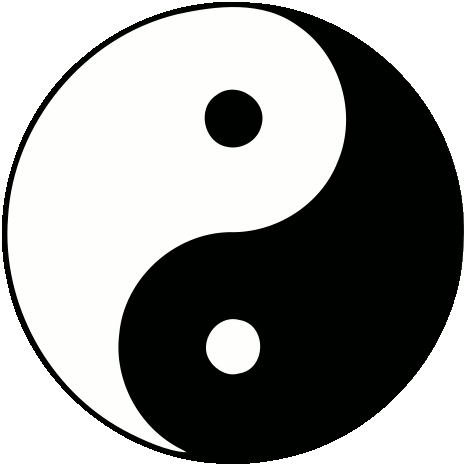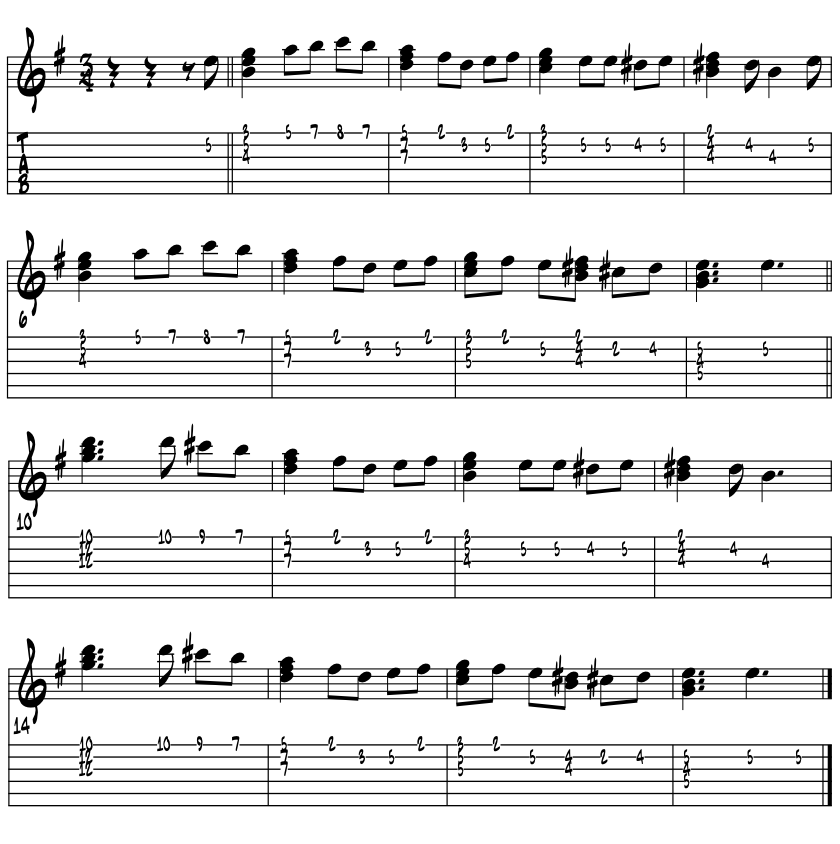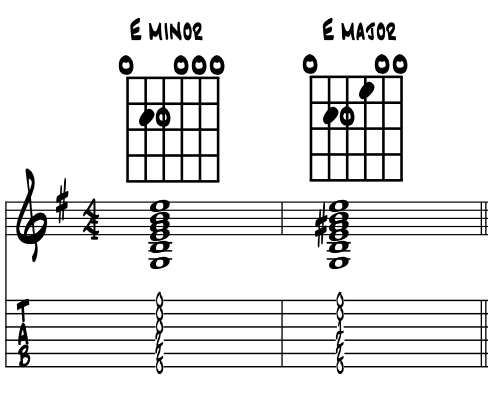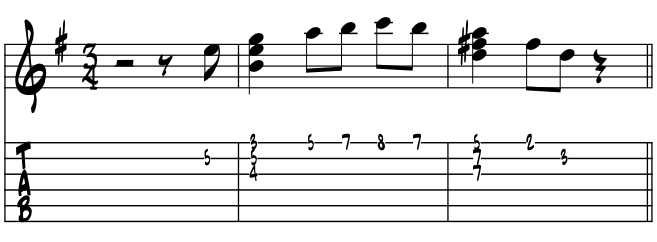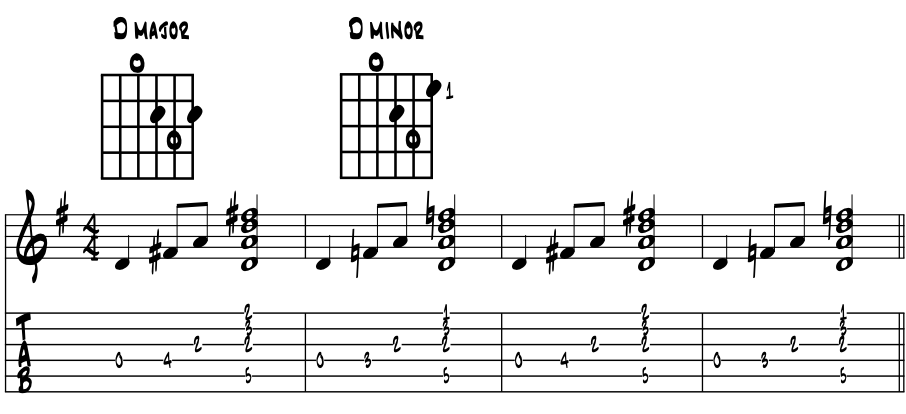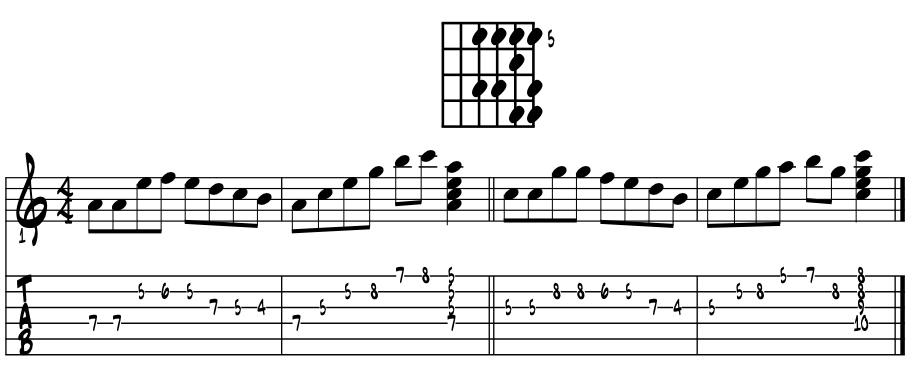|
'major 3rd or minor 3rd above the root note ... ?' ~ how our two ancient tonalities from one loop of pitches ~ ~ 'Yin ~ Yang' balance of emotions to tell our stories ~ ~ major / relative minor ~ minor / relative major ~ ~ 'C' major scale / 'A' minor scale ~ |
||||||||||||||||||||||||||||||||||
3 ~ 2 repeating black key pattern relative key centers of identical pitches |
||||||||||||||||||||||||||||||||||
|
what's not to love :) |
|
||||||||||||||||||||||||||||||||
In a nutshell ~ major or minor ... ? The Yin / Yang, major / minor dualism of a component or idea, such as a chord or melody riff, we can define as being either 'major or minor', and once determined, the music theory begins to order itself into storytelling. And knowing that these major / minor qualities go all the way back in our histories of music making brings past and present together as one balancing of energies today. Click the keys. Example 0. |
3 ~ 2 repeating black key pattern relative key centers of identical pitches |
| Cool ? Recognize the melodies ? And aurally recognizing this distinction, between major and minor, is easy mostly because it is either going to be one or the other, ( super rare to be both simultaneously ) and major always sounds major and minor always sounds minor. And while it might take a few repeated tries to consistently recognize both, the sound of something 'major', and something 'minor', it will surely happen with your own persistence and wanting to learn and then you'll know it forever. |
And once we can distinguish between these two essential colors, lots more of our music theory sorts itself out, as its puzzle pieces, placed along side one another, form identifiable loops; encouraging a next level understanding of the theories associated with music's essentials; scales, modes, arpeggios, chords, key centers, creative / compositional environments, all will lean major or minor, and all while freely combining both energies. And once we hear it and know this distinction, we'll know it forever and recognize and distinguish one from another in any song. |
So give it a try. For the emerging theorist, can you distinguish between our major and minor triads sounds by ear? Click on the following icons and see if you can. Example 1. |
#1 |
#2 |
#3 |
#4 |
Answers. Hold up to mirror :) ronim / rojam / rojam / ronim. |
Well how did you do? Get a few? Get them all? Miss them all? Miss them all but in reverse? Try them again? Keep trying and by the close of this discussion I predict you'll be on the road to major / minor aural perfection! |
We theorists often strive to be able to hear and understand the underlying theory of the pitches involved in the music we are listening to. As players, knowing what we are hearing plays a rather large role in jamming and in improvising musical lines. Surely where there's a will there's a way. |
This idea of reconfiguring the same musical elements, into different musical styles lives, right at the core of the EMG philosophy of becoming a modern guitarist and artist. Distinguishing between major and minor is simply a giant first step in our continuing evolutions. |
First lick for the two. Decades back I heard a cat shedding in a practice room at college. Here's the basis of the lick they were playing. Two bar phrase in 4 / 4, here from the root pitch 'G.' Example 1a. |
Cool with bass clef ? Walking a storyline in the bass? Minor into major. Old time New Orleans rite, first the way there and then the heading on back home :) |
Every picture tells a story. We can think of these major and minor colors as creating the two core emotional environments that we so often balance in creating our compositions. Thus, we can draw a comparison to the Yin / Yang, the ever expanding and contracting energies of our local universe. Perhaps you've seen this symbol representation of this duality? If not then chalk up yet another first here at Essentials! I wonder how far back in our earthly people history this symbol goes? |
|
major / minor |
Yin / Yang ~ major / minor balance. In what follows, we'll use a melody from the late 16 century to provide us with a lovely and timeless song to examine the balancing of the major and minor tonal colors within one song. Actually it'll be minor first, then into major, as the tune unfolds. And in today's Yin / Yang lingo ? |
"You have to both understand the box and be able to think outside it." |
wiki ~ Paul Krugman
|
Into the wayback machine. This next musical idea goes wayback to the later 1500's to locate probably what was the top 40 hit of late16th century London. Luckily for us, "Greensleeves" has not only survived but has thrived, especially during the winter holidays, and today is still an inspirational and joyous song to so many of us. Heavily covered through the ages, learn it here if new. Example 2. |
Which is which ? The first phrase is in the 'E' minor tonality. The second phrase, starting at measure 10, is in the major tonality with the sounding of the 'D' major chord. The music then cycles downward diatonically before closing in measure 16 back in 'E' minor. Click it again and again and again to hear and sing along with the chart and track learning deep the major / minor sounds. Might take 10 tries to hear the difference, then it takes 10, no worries. Then you got it forevermore :) |
Melody and chords of "Greensleeves." Looking at the first couple of bars, one sharp in the key signature puts us in 'E' minor / 'G' major. Example 3. |
With the eighth note pickup of our root pitch 'E', we leap a minor third to the pitch 'G', as the lead voice of an 'E' minor triad. Our phrase continues toward the second full measure where on beat one we find the 'D' major triad. So in just two measures we get both the major and minor tonalities. Is this uncommon? Nope, just simple diatonic chord progressions. Hear the major / minor distinction between these chords? Cool. |
Analyze the pitches. So looking at the 'E' minor chord, what makes it tick. The following chart starts with the 12 pitches of the chromatic scale. Then from this group of 12 we extract the seven pitches we need to make up the 'E' natural minor scale. These become the diatonic, core pitches used to compose "Greensleeves." We then locate the pitches of the three pitch E minor diatonic triad. Example 3a. |
chromatic
scale |
E |
F |
F# |
G |
G# |
A |
A# |
B |
C |
C# |
D |
D# |
E |
natural minor scale degrees |
1 |
. |
2 |
3 |
. |
4 |
5 |
6 |
. |
7 |
. |
8 |
|
E natural minor pitches |
E |
. |
F# |
G |
. |
A |
. |
B |
C |
. |
D |
. |
E |
E minor triad |
E |
. |
. |
G |
. |
. |
. |
B |
. |
. |
. |
. |
. |
Triads 1 / 3 / 5. Triads are three pitches that when sounded together create the foundation for chords. Seen in the chart just above, from any group of pitches and from any root pitch (1), we're looking for the root pitch 1, the 3rd, and 5. Triads are three note chords always major or minor. We hear triads a lot in creating melodies. We stack the three pitches one atop another and sound them together make our triads, the basis of chords. |
Root and fifth. The root and the fifth notes of the triad, above the pitches 'E and B', are always the same regardless of major or minor. So that leaves the third of the scale or chord, in this case the pitch 'G', to determine the major or minor quality of our triads. So, need to determine the quality of the third. Major third or minor third interval above the root? Well, first let's let our ears decide. Example 3b. |
Easy do? So which is which then mon ami? Looks like the third in the second bar is a wee bit bigger than the first, what with the # / sharp raising the 'G' up a half step to 'G#.' Does this wee bit 'majorize' the interval by raising it a half step? It sure does. And the chords in the third and fourth bars? |
Turns out the sounds of measures one and three are minor thirds and the pitches / chords in two and four are major. Is that what you came up with? Cool. It's all very straightforward for sure, but this super crucial bit of info will influence lots of your musical musings. |
Here are two essential open chords expanding a bit on the above chord voicings. These shapes are very common in lots of the Americana sounds; folk, blues / rockabilly and beyond. Singer / songwriter Johnny Cash loved these chords, open, or even tuned down a step or capo'd to match his voice that day. "I hear the train a comin ..." sound. Example 3c. |
|
Look familiar? Cool. If not then maybe get 'em right now. These two voicings are oftentimes among the first chords we learn when first starting out with the guitar. We can fit them into lots of styles. There are a couple of easy hammer-on's between the two, especially when we hammer - on the major 3rd, adding the major third from the open string minor. A very common blues lick. |
The basic chord shape, of which we have a minor and major version as shown just above, handily transforms into a barre chord, those movable chunks of harmony beloved by the 60's and 70's cats and onward, of the blues / rock / Southern and folk rock / West Coast jamm et al. Doesn't the barre finger take the place of the capo in moving things around? It sure does. |
Quick review. So in our three note chords, which we call triads, the root and fifth of either the major and minor triads are always the same. It is the third of the chord, and its interval distance measured from the root pitch, which determines the major or minor sonority of any triad or chord. Triad = 3 notes ~ a chord = 3 notes more pitches. This is a set in stone rule for major and minor triads. It has been this way kind of forever. Once the equal temper tuning came into vogue, we could then project this basic theory from each of the 12 pitches of the chromatic scale on one instrument. |
... Once the equal temper tuning came into vogue, we then could project this basic theory from each of the 12 pitches of the chromatic scale, all on one instrument. The piano? Yep, the piano, but that was in 1700. Before that? Ah yes, there was a before that, some cats had the 'rule of 18' to guide their building to create tune-able chords in multiple keys, in one stringed instrument. The lute? Yes. Other instruments ? Perhaps :) |
So is it the third scale degree which determines the major or minor quality of scales and arpeggios too? Is it the 'third of anything' musical that determines major or minor ? 'Tis is indeed and this never ever ever varies :)' |
The flip side. Can we reverse this process and make a major chord minor by lowering its third by half step? Let's examine the 'D' major chord from the above idea, hear its sound, examine its pitches and flip it from being a major triad to a minor triad. Here again is the first phrase of "Greensleeves." Example 4. |
Analyze the pitches. Now recreate the same diatonic pitch / chord spelling process as above but now looking at the 'D' major triad. Again the following chart starts with the 12 pitches of the chromatic scale but this time using the pitch 'D' for our starting point. Then from this group of 12, we extract the seven pitches we need to make up the 'D' major scale. We then locate the three pitches of our 'D' major triad. Root / 1, major 3rd and perfect 5th. Example 4a. |
chromatic
scale |
D |
D# |
E |
F |
F# |
G |
G# |
A |
A# |
B |
C |
C# |
D |
major scale degrees |
1 |
. |
2 |
. |
3 |
4 |
. |
5 |
. |
6 |
. |
7 |
8 |
D major scale pitches |
D |
. |
E |
. |
F# |
G |
. |
A |
. |
B |
. |
C# |
D |
D major triad |
D |
. |
. |
. |
F# |
. |
. |
A |
. |
. |
. |
. |
. |
Easy enough huh? We see again that by simply skipping every other note of the stepwise major scale, the triad pitches emerges. Is this how arpeggios come to life? Simply by skipping every other pitch of a stepwise scale? Tis' indeed the way. Any scale evolves into its arpeggio through this skipping process, spelling out triads. |
So if raising the third of the minor triad by half step makes it major, then lowering the major third by half step must make it minor? Absolutely and forevermore. Here are the pitches. Example 4b. |
major scale degrees |
1 |
. |
2 |
. |
3 |
4 |
. |
5 |
. |
6 |
. |
7 |
8 |
D major scale pitches |
D |
. |
E |
. |
F# |
G |
. |
A |
. |
B |
. |
C# |
D |
D major triad |
D |
. |
. |
. |
F# |
. |
. |
A |
. |
. |
. |
. |
. |
D minor triad |
D |
. |
. |
F |
. |
. |
. |
A |
. |
. |
. |
. |
. |
Root and fifth. Again we see how the root and the fifth of the chord are the constants in our triads. The third is the 'decider' of major or minor. Did you notice that the 'F' natural of the 'D' minor triad is not part of the 'D' major scale? Cool. If we found one of these 'F' natural in the music we'd call this a non-diatonic pitch. |
In pure theory, and thinking diatonically, we'd have borrowed this pitch to make the minor chord. And depending on the musical style, this borrowing or negotiating of the pitches is what we do all the time. In this next example, hear the sound of the above major / minor transition from 'D' major to 'D' minor, using common open chord guitar voicings. Example 4c. |
Hearing these major / minor sounds? While seemingly a simple distinction, not only is it tricky at first but as you progress, you'll discover ways to add additional pitches to the major and minor colors. In doing so we begin to disguise the transitions between the two and begin swapping, using one over the other and vice versa. We simply must have this 'either / or' starting point. Cool? major triad 1 3 5 ~ minor triad 1 b3 5 |
When major / minor goes away. In all of our Americana musical sounds and styles, from old time children's songs to the 'new modern' to be created tomorrow, these two musical 'sound colors' of major and minor form the essential basis of our music. And while there is music that is not major / minor based, we almost never hear it on the radio, in clubs or even the concert halls. If we do, we are usually forewarned somewhere in the advertising of the event, that some sort of new 'avant garde' music will be performed, and thus expressly not to be missed. |
And when we hear these new sounds, the 12 tone concept of tone rows for example, slipped in between major / minor tonality based music in a conventional concert or gig program, it sounds cool, refreshing and interesting to many curious listeners. But as a staple for the majority, who also want to dance on their feet or with just tapping toes and fingers, or even just a bit of gyroscoping around in their heads, the major / minor compositional pairing is just way too deep in our collective Americana psyche and history to shake. |
Being wildly successful in actually getting folks up to dance for the last couple of thousand years kind of seals the deal for our major / minor system :) And for a good part of our Americana musical journey, dancing really is at the core of it all. That the vast vast majority of our melodies and harmony, in all styles combined, come from the spiritually uplifting and often overly joyous major / relative minor grouping of pitches, should come as no surprise. |
The family relatives of major and minor. Now using the piano keyboard as our default, arguably the best physical representative of our system of music theory, its tuning and capabilities, we can easily coax forth both the relative 'C' diatonic major and the 'A' natural minor groups of pitches, from the exact same keys. Example 5. |
 |
As time permits. As time and considerations permit, do locate these pitches on any keyboard and explore. For nowadays, they are all the same. We can clearly see the black key grouping pattern of two then three, 2-3, which repeats over the range of the instrument, giving us yet another clue to the perfect closure of our equal temper tuning, and all of the musical and theoretical magics that are created with its 'equal compromise.' |
 |
These pitches in action. In the following idea, the same letter name pitches from the keyboard create two melodies. While not labeled in the music, can you hear which is major and which is minor? Example 5a. |
Hear the difference in the character of the two lines? How can the same pitches create both major and minor? Well, just as with the triads, it has to do with the interval distances between root and the scale degrees. Please examine the pitches and their intervals. Example 5b. |
scale degrees |
1 |
2 |
3 |
4 |
5 |
6 |
7 |
8 |
scale intervals |
root |
major 2nd |
major 3rd |
perfect 4th |
perfect fifth |
major 6th |
major 7th |
perfect octave |
relative minorscale intervals |
root |
major 2nd |
minor 3rd |
perfect 4th |
perfect fifth |
minor 6th |
minor 7th |
perfect octave |
All in the theory is in blue. Three, Six and Seven. All three of these intervals are either major intervals for creating the relative major group, or all three are minor intervals to create the relative minor group of pitches. The remaining four intervals and pitches, being 'perfect', stay the same. This last bit of the discussion is the essential theory seam that knits together much of the Americana sounds we love. |
Variations, borrowing and non-diatonic additions? Endless possibilities, as seen in the lovely "Greensleeves." For whatever the artist needs to tell their tale ... 'and as they often say ... all is in play.' Now there's a hook for ya :) |
Can we project this theory from any of our twelve pitches? And aren't Three and Seven the intervals used to determine chord type? Yep on both accounts. That, and depending on the style of music we choose to create, in good measure will often determine just how much of the 12 tone resource we use in its creation. From the educational perspective and philosophy here at UYM, knowing the full scope of our resource is the core catalyst to our artistic evolution of creative perspective. |
Cool? So if we can create loops from these two starting points within major / minor loop of seven pitches, can we follow suit and create loops with the remaining five pitches too? Well of course we can, we do it all here. So, do we have names for all seven groups, from within this relative major / minor set of pitches ? Of course we do, we have a name for everything theory here :) Are we creating the modes here Amigo ? Yep, these become our 'loops within a loop', the modes, those now ancient groups of pitches from which we create our ideas. |
|
That's all for this chapter folks. So all good with the fundamental theory of our major and minor colors? That it is the third degree above the chosen root pitch, of our scales, arpeggios and chords, that determines major and minor ? Although a rather simple process, it can be tricky at first and we really need to be able to hear the difference between these two essential colors. Yet once we lock in their sound, and consistently recognize major and minor in the musics we dig, we've surely elevated our understanding of our musical arts in a rather big way. |
|
A good way to start is probably with the music you love best and just try to figure out how major / minor is being woven together. Metalists are challenged here because their power chords often are usually only root and fifth, no major or minor determining third. So you'll probably have to use the melody. Blues artists end up considering the blues rub, where melody and harmony pitches do not diatonically line up. This is mostly about a minor 3rd blue note in the melody with a major 3rd in the supporting dominant V7 chord. Folk, pop and emerging jazz players probably have it the easiest, as their music is so often based on cyclical chord progressions of major and minor triadic based diatonic harmony. The diatonic 3 and 3? Yep. |
Another way to start is by reading through the numerous melodies of songs contained within this UYM work, which are mostly major with a few in minor. As many of these melody lines are also classic American melodies, their familiarity should help in learning to distinguish major and minor, to help read notation, and developing the ability to play and interpret melodies by ear. |
Advanced theorist. Already hip to the basis of our major and minors and looking to advance from this discussion? Empowered by knowing of the relationship between 'relatives', major and minor, perhaps go on to explore the evolutions of both the major and minor groupings of pitches. Explore the major and minor qualities of the diatonic modes. Explore and master the 'diatonic 3 and 3' in a couple of keys; all 12 keys for jazzers. Another valence level explores the three basic chord types; two major and one minor, in our common diatonic chord progressions, in both the major and minor tonal environments, and then on into chord substitutions. Beyond these pathways, there is always the major Lydian and minor Dorian looping connection at the #15 colortone to explore and muse about. |
What's next? We've now spent the first three theory discussions with the origin of our pitches and the closed system of architecture they create. In this last discussion we've examined the basic division of major and minor sounds that form the basis of so much of the Americana musics we love. The next theory discussion builds on this foundation to examine the various groupings of these pitches from which we create our musical ideas. |
Coda. To find "middle C", sit at the middle of the piano, extend your arms outward to touch the furthest keys you can, then bend from the waist and bring your nose to gently touch the keys. The closest 'C' should then be "middle C." |
'They who conquer others are strong, those who conquer themselves are mighty.' |
'... be mighty.' |
References. References for this page come from the included bibliography from formal music schools and the bandstand, made way easier by the folks along the way. In addition, books of classical literature; from Homer, Stendahl and Laudurie to Rand, Walker and Morrison and of today, provided additional life puzzle pieces to the musical ones, to shape the 'art' page and discussions of this book. Special thanks to PSUC musicology professor Dr. Y. Guibbory, who 40 years ago provided the initial insights of weaving the history of all the fine arts into one colossal story telling of the evolution of AmerAftroEurolatin musical arts. And to teacher-ed training master, Dr. Joyce Honeychurch of UAA, whose new ideas of education come to fruition in an e-book. |
"Life is about creating yourself." |
wiki ~ Bob Dylan |
Find an e-book mentor. Always good to have a mentor when learning about things new to us. And with music and its magics, nice to have a friend or two ask questions and collaborate with. Seek and ye shall find. Local high schools, libraries, friends and family, musicians in your home town ... just ask around, someone will know someone who knows someone about music who can help you with your studies of the musical arts with this e-book. |
Intensive tutoring. Luckily for musical artists like us, the learning dip of the 'covid years' can vanish quickly with intensive tutoring. For all disciplines; including all the sciences and the 'hands on' trade schools, that with tutoring, learning blossoms to 'catch us up.' In music ? The 'theory' of making musical art is built with just the 12 unique pitches, so easy to master with mentorship. And in 'practice ?' Luckily old school, the foundation that 'all responsibility for self betterment is ours alone.' Which in music, and same for all the arts, means to do what we really love to do ... to make music :) |
 |
"These books, and your capacity to understand them, are just the same in all places. Always bear in mind that your own resolution to succeed, is more important than any other one thing." |
|
Academia references of Alaska. And when you need university level answers to your questions and musings, and especially if you are considering a career in music and looking to continue your formal studies, begin to e-reach out to the Alaska University Music Campus communities and begin a dialogue with some of Alaska's finest resident maestros ! |
|
Formal academia references near your home. Let your fingers do the clicking to search and find the formal music academies in your own locale. |
"Who is responsible for your education ... ? |
'We energize our learning in life through natural curiosity and exploration, and in doing so, create our own pathways of discovery.' Comments or questions ? |





